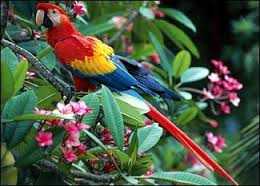Collpas or Clay licks of Manu
National Park and the Tambopata Reserved Zone
Manu National Park is a
protected area located in southeastern Peru, partially located in the
departments of Cusco and Madre de Dios, in the provinces of Manu and
Paucartambo. It has an area of 1,532,806 hectares, is divided into three major
areas: the National Park, with 1,155,806 ha; Reserved Zone, with 257 000 ha;
and Transition Zone and Cultural Materials, with 120,000 ha. Facilities include
cataloging as Biosphere Reserve.
In Manu and Tambopata there
are certain places with special characteristics, called Collpas, where many
species flock of parrots and other parrots to ingest minerals that complement
your diet.
The parrots (Psittacidae)
are a family of birds commonly called parrots psittaciformes or parrots,
including macaws, parrots and related forms of the Americas and Africa. It is
classified within the Psittacoidea superfamily with the other two families of
typical parrots: psittrichasiidae and psittaculidae.
The "Collpa" is a
Quechua name of the places where many species of animals congregate to eat soil
minerals. Scientists believe that this behavior supplementing the diet of these
animals. Also it states that ingestion of soil reduces the toxic effects of
some wild fruits and seeds. A widely accepted theory is that just looking
sodium as selected areas have a high content of the mineral.
In the collpa or clay lick in
Manu, you can observe and photograph hundreds of parrots of medium and large
macaws and red and green that come to this place to eat. During the months of
May, June and July in the clay lick activity it is lower than in the months of
August and September.
In the Tambopata Reserve,
it is the large clay lick, on the left bank of the Tambopata River, known
worldwide for its spectacular and considered the largest in the Peruvian
Amazon, because there concur many macaws, parrots and parakeets.
There are also smaller clay
lick in the Heath River macaw. The Chuncho lick is a low cliff located along a
tributary of the Tambopata, 5 hours upriver from Puerto Maldonado. The Colorado
clay lick is an hour upstream from the Chuncho lick, is a cliff of higher
altitude.
Some common species seen in
these places are blue green and gold macaw, scarlet, red and blue-headed
parrots and parakeets. Monkeys, tapirs, deer and capybaras are also frequently
seen.
Every morning at 6:00 am,
made his fluttering ceremony before starting the "colpeo" which
consists of ingesting clay in the river gorge and after 25-30 minutes removing
Iran to return the next day. They were also observed macaws groups at other
times but not as safe and usually are smaller groups.
Enlace recomendado
References
MANU WILDLIFE CENTER
COLLPA DE GUACAMAYOS
Reserva
nacional Tambopata
Collpas
en el Rio Tambopata
Psittacidae

















































